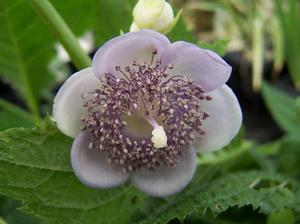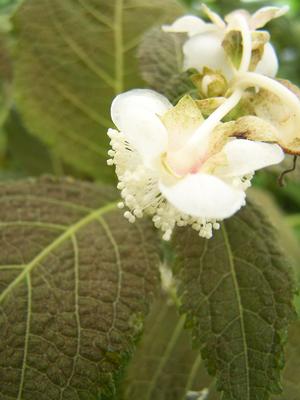
Deinanthe caerulea 'Blue Wonder': close up of a single floret.

Deinanthe bifida 'Pink Kii' showing an October bronze leaf tint but washed-out flowers (though still lovely!)
Deinanthe - The False Hydrangea
Two herbaceous woodlanders which are closely related to the shrub hydrangeas are beloved by some of the more practiced gardeners among our esteemed if not scary lot. Deinanthe (dine-ANTH-ee) is the fusion genus name from two Greek words, "deinos" meaning "wondrous" and "anthe" translating to "flower". The genus Deinanthe (dine-ANTH-ee) contains two members with wondrous flowers, Deinanthe bifida and D. caerulea.
DEINANTHE BIFIDA 'PINK KII'
Deinanthe bifida 'Pink Kii' is from Japan. ‘Pink Kii’ which we purchased many years ago from the original Heronswood Nursery when under the ownership of the great plant explorer, Dan Hinkley, was originally collected from Kii Peninsula, Japan.
Flowers open from round pink buds in early summer. The inflorescence structure is basically an umbel in that they occur clustered at the apex of stems. Peduncles curve over and the flowers hang down. An established plant will produce a carousel of florets per flowering stem. Six to possibly eight rounded light pink overlapping sepals which appear as concave petals per cup-shaped floret. Each flower is waxy and of thick substance. Flower centers are a showy complex of anthers that circle the central extended white pistil. Remember, "deinanthe" refers to the wondrous anthers. A single stem is beautiful; en masse they are just resplendent. Plants grow 15 to 18 inches tall, possibly up to 24, with equal spread eventually growing even wider when left undisturbed over the course of years. D. bifida is hardy through USDA zone 5, possibly into the warmer parts of zone 4. It extends its reach through zone 7 and very possibly into 8.
As the species name indicates established plants exhibit a bifid leaf form. Leaves culminate in two points with a prominent indentation declining from those two points to the central vein. Our younger plants and those in smaller pots mostly display leaves culminating in a single point. But when the bifid trait manifests on an established clump they are distinctive and handsome. Leaves are matte-finished, a touch hirsute and broadly obovate. Deinanthe can be relatively bold as relates to their garden companions, for instance, when paired with Epimedium, Maidenhair or Japanese Painted Ferns. Boldness is diminished when planted with larger-leaved associates such as Glaucidium palmatum, Arisaema fargesii, A. ringens or Peltoboykinia tellimoides. With a backdrop of Osmunda regalis they are stunning. And stately contrast is achieved when paired with good old-fashioned Polygonatum odoratum 'Variegatum', or any among the variegated Solomon's Seal. This clumping perennial becomes more and more beautiful through the years without having to divide it.
DEINANTHE CAERULEA 'BLUE WONDER'
Deinanthe caerulea offers beautiful blue flowers. 'Blue Wonder' displays lovely, down-turned waxy blue and white flowers comprised of rounded sepals with showy anthers in early summer over medium green bifid, finely hirsute leaves. Also growing from 15 to 18 inches but can attain domed heights of 24 inches the flowers occur terminally in early summer from round, bluish buds. Deinanthe caerulea mimics look, disposition and habit of its pink cousin but in two ways. Deinanthe caerulea originates in China though it may be slightly more cold hardy, extending the USDA hardiness range through zone 4. 'Blue Wonder' appears to be a trade name someone attached to the specie solely for the purposes of marketing. From all that we glean there are no actual specie selections as of the time of this writing though there is at least one hybrid between the two species. In any incarnation Deinanthe caerulea is just plain wonderful.
At the time of this writing there is some question as to whether plants sold under the D. caerulea species designation in the U.S. are actually hybrids between D. caerulea and bifida. Nevertheless, the flowers are blue and worthy.
A common moniker for both species is False Hydrangea. However, in that they are Deinanthe, and dine-ANTH-ee is as easy to get off the tongue as hydrangea, we prefer to give them the proper respect of their actual name... and there is nothing false about either of these fine plants. With the logic of the common name in this application it would be equally irresponsible to slur Hydrangea macrophlla as False Deinanthe!
Culture is easy for both species. Fertile soil amended with moisture retaining organic matter sets the floor. Moisture retention is a fundamental requirement. In a soil that drains too quickly between rains or a soil that becomes dry in drought conditions the plants will communicate their displeasure very quickly with weeping foliage. Mulch is helpful in maintaining soil moisture for longer, keeping down weeds and as it breaks down will provide nutrients to the soil which in turn will feed the plants. But plant your Deinanthe in a low, damper part of your garden to assuage unhappiness. Open to dappled shade is perfectly appropriate. Too much deep shade and the plants will not flower. Deinanthe will tolerate some morning sun. In this siting constant moisture is even more pertinent.
These wonderful plants require little care once established. Over the course of years they gradually become more substantial with more flowering stems and just plain more beautiful. They die down to the crown when frosts hit. Simple cleanup by removing spent stems is all that may be required. Keep them mulched, not too deep mind you - just about two inches of leaf mold and / or fine wood chips will provide enough replenishment to maintain their good looks. Clean up is easy. Ours have never been pesetered by the four or six-legged predators.
We strongly feel that you will come to appreciate these fine hydrangea relatives. When you do you will not want to be without them. You, too, can become a more sophisticated gardener just through the largesse of your spirit and an open mind to new plants - especially those that are so easy to please such as these under present discussion. You might even become the esteemed scary gardener! Deinanthe bifida 'Pink Kii' and D. caerulea 'Blue Wonder' with their ease of culture and attractive, casual demeanor in the landscape could be the perfect plants to expand your palette. Dig in and have fun.
Penned by Wayne Paquette, March 2015